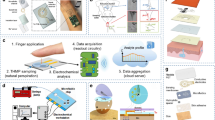Abstract
Multiple chemical sensitivity (MCS) has become a serious problem as a result of airtight techniques in modern construction. The mechanism of the MCS, however, has not been clarified. Responsible chemicals and their exposure levels for patient's hypersensitive reactions need to be identified. We measured the exposure of 15 MCS patients to both carbonyl compounds and volatile organic compounds (VOCs) that may induce hypersensitive reactions. The exposures of those not suffering from MCS (non-MCS individuals) were also measured at the same time. To characterize the chemicals responsible for MCS symptoms, we applied a new sampling strategy for the measurement of carbonyls and VOCs using active and passive sampling methods. The results of our study clearly demonstrated that the chemicals responsible for such hypersensitive reactions varied from patient to patient. Moreover, the concentrations during hypersensitive symptoms, which were apparent in some of the MCS patients, were far below both the WHO and the Japanese indoor guidelines. The average exposure levels of MCS patients within a 7-day period were lower than those of paired non-MCS individuals except for a few patients who were exposed to chemicals in their work places. This result indicates that the MCS patients try to keep away from exposures to the chemical compounds that cause some symptoms.
This is a preview of subscription content, access via your institution
Access options
Subscribe to this journal
Receive 6 print issues and online access
$259.00 per year
only $43.17 per issue
Buy this article
- Purchase on Springer Link
- Instant access to full article PDF
Prices may be subject to local taxes which are calculated during checkout



Similar content being viewed by others
References
Bolla K.I . Use of neuropsychological testing in idiopathic environmental testing. Occup Med 2000: 15(3): 617–625.
Cullen M.R . The workers with multiple chemical sensitivities. Occup Med 1987: 2(4): 655–661.
Davidoff A.L., and Keyl P.M . Symptoms and health status in individuals with multiple chemical sensitivities syndrome from four reported sensitizing exposures and a general population comparison group. Arch Environ Health 1996: 51(3): 201–213.
Gallant L . Biochemical abnormalities in patients with multiple chemical sensitivities. Occup Med 1987: State of the Art Reviews 2: 713–720.
Japanese Ministry of Health and Welfare. Survey of VOCs levels in the house. Tokyo Internet report, 1999.
Jensen L.K., Larsen A., Molhave L., Hansen M.K., and Knudsen B . Health evaluation of volatile organic compound (VOC) emissions from wood and wood-based materials. Arch Environ Health 2001: 56(5): 419–432.
Kikuchi H., Ichibe Y., Namba T., Miyata M., and Ishikawa S . Neurological–ophthamological finding of patients with chemical sensitivity. Jpn J Clin Ecol 2000: 9(1): 22–27.
Kostiainen R . Volatile organic compounds in the indoor air of normal and sick houses. Atmos Environ 1995: 29(6): 693–702.
Meggs W.J., Dunn K.A., Bloch R.M., Goodman P.E., and Davidoff A.L . Prevalence and nature of allergy and chemical sensitivity in a general population. Arch Environ Health 1996: 51: 275–282.
Miller C.S . White paper. Chemical sensitivity: history and phenomenology. Toxicol Ind Health 1994: 10: 253–276.
Miller C.S., and Mitzel H.C . Chemical sensitivity attributed to pesticide exposure versus remodeling. Arch Environ Health 1995: 50: 119–129.
Molhave L . Indoor climate, air pollution, and human comfort. J Exp Anal Environ Epidemiol 1991: 1(1): 63–81
Otto D., Molhave L., Rose G., Hudnell H.K., and House D . Neurobehavioral and sensory irritant effects of controlled exposure to a complex mixture of volatile organic compounds. Neurotoxicol Teratol 1990: 12(6): 649–652.
Rea W.J . Injection therapy, intradermal testing, and subcutaneous injection treatment. Chem Sensitivity 1997: 4: 2481–2540.
Shinohara N., and Yanagisawa Y . A new methodology to identify responsible carbonyl compounds inducing hypersensitivity. Indoor Air, accepted.
Shirakawa S., and Rea W.J . Evaluation of the autonomic nervous system response by pupillographical study in the chemically sensetive patients. Environ Med 1991: 8: 121–127.
U.S. EPA. Determination of Volatile Organic Compounds in Ambient Air using Active Sampling Onto Sorbent Tubes: Compendium Method TO-17, 2nd edn. US Environmental Protection Agency, Washington, DC, 1999.
Wargocki P., Wyon D.P., Baik Y.K., Clausen G., and Fanger P.O . Perceived air quality, sick building syndrome (SBS) symptoms and productivity in an office with two different pollution loads. Indoor Air 1999: 9(3): 165–179.
Acknowledgements
We thank Dr. Yoshinaga, Dr. Fujii, Mr. Kumagai, Mr. Yamamoto, and Mrs. Saitho (all of the University of Tokyo); Dr. Yamasaki (National Institute of Advanced Industrial Science and Technology); and Dr. Ishikawa, Dr. Miyata, and Dr. Sakabe (at the Kitasato Institute Hospital) for their valuable contributions to our research. This study was supported by the Special Coordination Funds for Promoting Science and Technology from the Science and Technology Agency of Japan.
Author information
Authors and Affiliations
Corresponding author
Rights and permissions
About this article
Cite this article
Shinohara, N., Mizukoshi, A. & Yanagisawa, Y. Identification of responsible volatile chemicals that induce hypersensitive reactions to multiple chemical sensitivity patients. J Expo Sci Environ Epidemiol 14, 84–91 (2004). https://doi.org/10.1038/sj.jea.7500303
Received:
Accepted:
Published:
Issue Date:
DOI: https://doi.org/10.1038/sj.jea.7500303
Keywords
This article is cited by
-
Characterization of the variation of carbonyl compounds concentrations before, during, and after the renovation of an apartment at Niterói, Brazil
Environmental Science and Pollution Research (2016)
-
Isolation and Identification of Toluene-Metabolizing Bacteria from Rhizospheres of Two Indoor Plants
Water, Air, & Soil Pollution (2013)
-
Formaldehyde Removal from Air by a Biodegradation System
Bulletin of Environmental Contamination and Toxicology (2010)
-
Symptoms in relation to chemicals and dampness in newly built dwellings
International Archives of Occupational and Environmental Health (2004)



